Several industry reports highlight the significant ROI businesses can expect from implementing automation technologies like Yoroflow. According to Deloitte’s AI ROI Report (2020), mature companies achieved an average ROI of 4.3%, compared to just 0.2% for beginners, with a payback period of 1.2 years. Forbes reported that AI-driven automation resulted in a 50% reduction in document handling times and a 25% increase in task completion rates, alongside 20-30% operational cost savings within 12-18 months. These findings emphasize the potential for enhanced productivity, customer satisfaction, and overall ROI.
Introduction
In today’s fast-paced and highly competitive business landscape, organizations are increasingly turning to technology to streamline operations, improve efficiency, and enhance overall performance. One such tool gaining traction is Yoroflow, an innovative workflow automation platform designed to help businesses optimize their processes and drive growth. By automating repetitive tasks, improving collaboration, and minimizing human error, Yoroflow empowers organizations to focus on strategic initiatives that contribute to their success.
Understanding the Return on Investment (ROI) of implementing new technologies is crucial for businesses. ROI provides a clear measure of the financial benefits derived from an investment relative to its cost. For organizations considering the adoption of Yoroflow, a thorough ROI analysis can help justify the investment by highlighting potential savings, increased productivity, and overall improvements in operational efficiency.
This white paper aims to provide a comprehensive analysis of the ROI associated with implementing Yoroflow in businesses of various sizes. It will explore the benefits of the platform, present a framework for calculating ROI, address potential challenges during implementation, and illustrate the tangible outcomes of adopting Yoroflow. By the end of this paper, readers will gain valuable insights into how investing in Yoroflow can lead to significant financial and operational advantages, ultimately supporting their strategic goals and long-term success.
Yoroflow and Its Capabilities
Yoroflow is a comprehensive workflow automation platform designed to streamline business processes and enhance productivity. It offers a suite of tools that include task automation, project management, and integration capabilities, allowing organizations to optimize operations and improve collaboration across teams. By harnessing the power of automation, Yoroflow enables businesses to reduce manual effort, minimize errors, and accelerate project timelines.
Importance of ROI in Technology Implementation
Calculating ROI is critical for businesses considering new technology investments, such as Yoroflow. It helps organizations understand the financial benefits of automation and ensures that resources are allocated effectively. A clear ROI analysis allows businesses to justify their investments, anticipate future savings, and measure the success of implemented technologies. By focusing on ROI, organizations can align their technological strategies with overall business goals, ensuring that they derive maximum value from their investments.
Here are the key reasons why ROI analysis is important:
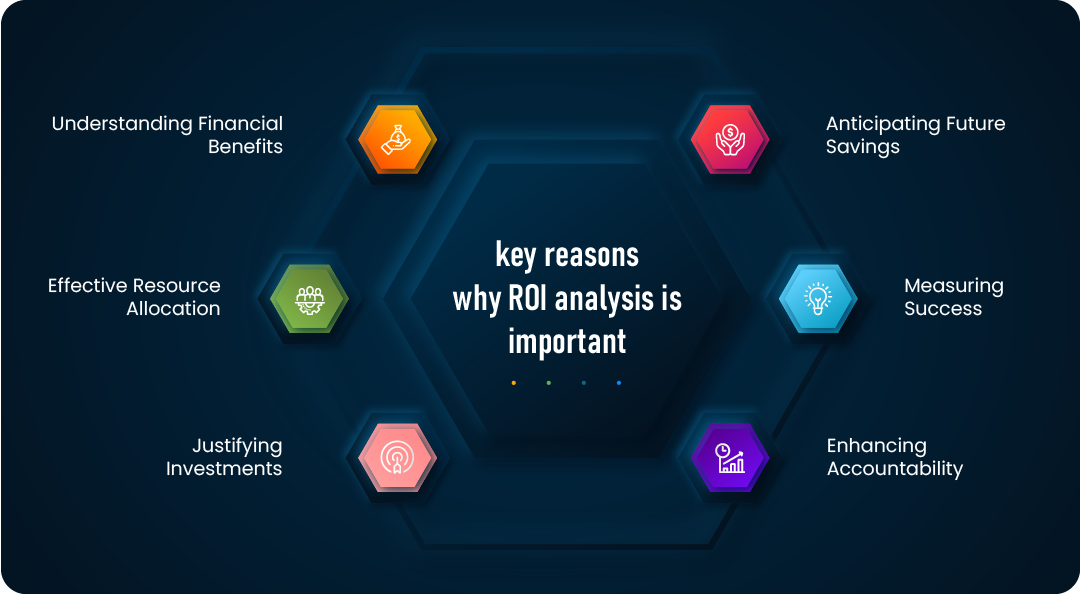
Understanding Financial Benefits:
ROI quantifies the financial gains from technology investments, helping organizations assess whether the benefits outweigh the costs. This enables informed decision-making and prioritizes high-return projects.
Effective Resource Allocation:
A clear ROI analysis facilitates strategic budgeting and mitigates financial risks by directing funds to initiatives likely to deliver substantial returns, optimizing limited resources.
Justifying Investments:
ROI serves as a compelling business case for stakeholders, gaining support from executives and board members who may be hesitant to allocate resources to new technologies.
Anticipating Future Savings:
By analyzing projected ROI, organizations can plan for long-term savings and growth, enabling them to remain financially sound while scaling effectively.
Measuring Success:
ROI provides tangible metrics for evaluating technology performance, allowing organizations to compare actual results against projections and ensure alignment with business goals.
Enhancing Accountability:
Establishing clear ROI metrics fosters accountability within teams and encourages a results-driven culture that prioritizes performance and efficiency.
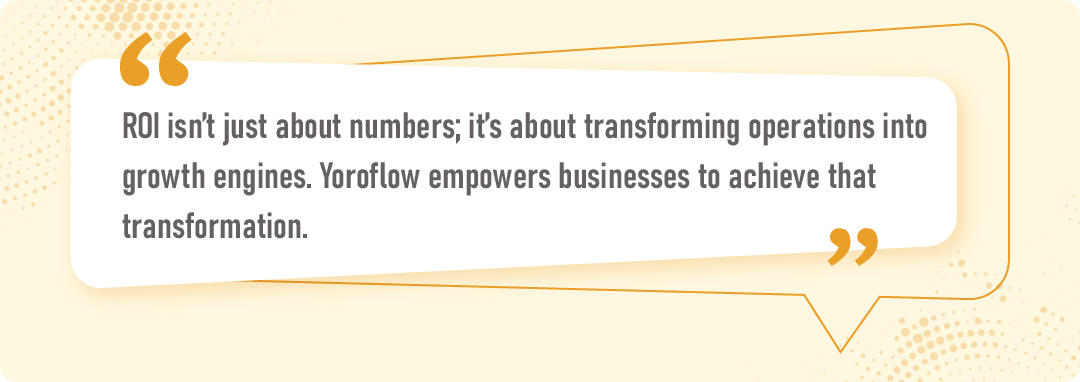
Understanding ROI
Return on Investment (ROI) in software implementation is a financial metric that measures the efficiency and profitability of a technology investment relative to its cost. ROI provides businesses with a quantifiable way to evaluate the benefits of adopting new software, such as workflow automation tools like Yoroflow. In this context, ROI calculates the monetary value gained from implementing the software against the total cost of investment, which includes software licenses, implementation costs, training, and maintenance. A high ROI indicates that the software is generating more value than it costs to implement and operate.
The formula for calculating ROI is typically expressed as:

Key Metrics and Factors Influencing ROI
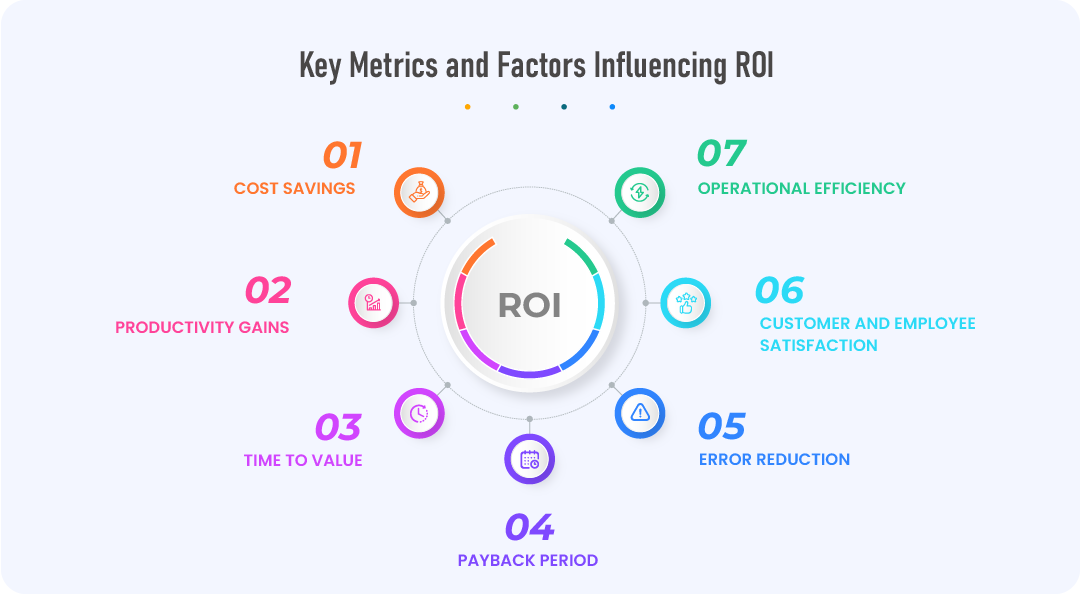
Several key metrics and factors can influence ROI when it comes to software implementation:
Cost Savings:
A significant part of ROI comes from the reduction in operating costs. For automation tools like Yoroflow, this could be due to time saved from automated tasks, fewer errors, and reduced labor costs.
Productivity Gains:
Measuring increased productivity is crucial in understanding ROI. For example, if a team can complete tasks 30% faster due to workflow automation, the productivity boost directly impacts ROI by reducing the time to deliver products or services.
Time to Value:
This refers to the time it takes for the software investment to generate measurable benefits. Faster implementation and integration processes often lead to a quicker realization of ROI.
Payback Period:
The payback period is the time it takes to recover the initial investment in software. According to Deloitte, organizations implementing AI-driven automation saw payback within 1.2 years, with those adopting best practices recovering their investment faster.
Error Reduction:
Fewer errors, particularly in document management or data entry, reduce rework and associated costs. Forbes reports that automation tools can reduce manual errors by up to 50%, leading to substantial cost savings.
Customer and Employee Satisfaction:
Enhanced user experience and employee engagement also contribute to ROI. Satisfied employees are more productive, and streamlined customer service improves retention, both of which drive financial returns.
Operational Efficiency:
Automation can significantly reduce the time and resources spent on repetitive tasks. For instance, Gartner found that businesses implementing AI in customer service experienced 30% higher customer retention and faster task completion times, which directly contribute to a positive ROI.
Methodology for ROI Analysis
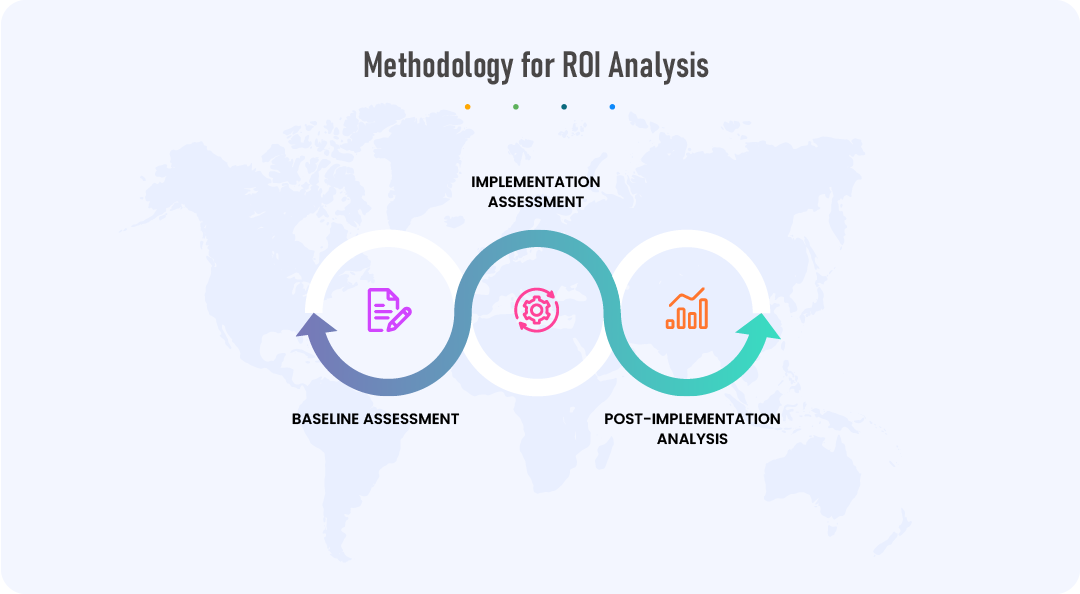
The ROI analysis of Yoroflow is conducted using a structured approach that quantifies both tangible and intangible benefits. It involves three main stages:
Baseline Assessment:
Evaluates current business processes, identifying inefficiencies, manual work, and associated costs, to establish pre-implementation metrics.
Implementation Assessment:
Tracks the investment in software licensing, training, and system integration during the deployment phase, detailing initial costs and the onboarding process.
Post-Implementation Analysis:
Measures key metrics like time savings, error reduction, and productivity improvements after deploying Yoroflow. These are compared against baseline metrics to assess the platform’s impact on operational efficiency and cost savings.
How can Yoroflow enhance your ROI?
Yoroflow offers several key advantages that contribute to improving your return on investment. By automating repetitive tasks, it reduces labor costs and saves time, leading to operational savings of 20-30%, as reported by Deloitte. Additionally, businesses have experienced efficiency gains of 20-40%, allowing teams to focus on higher-value activities.
Moreover, Yoroflow minimizes errors in processes, with organizations seeing reductions in error rates by up to 75%, thus avoiding costly rework. Enhanced data analytics further supports decision-making, enabling more strategic planning and profitability improvements. Finally, the platform's scalability ensures that it grows with your business, eliminating the need for further investments in new software.
Features of Yoroflow That Drive ROI
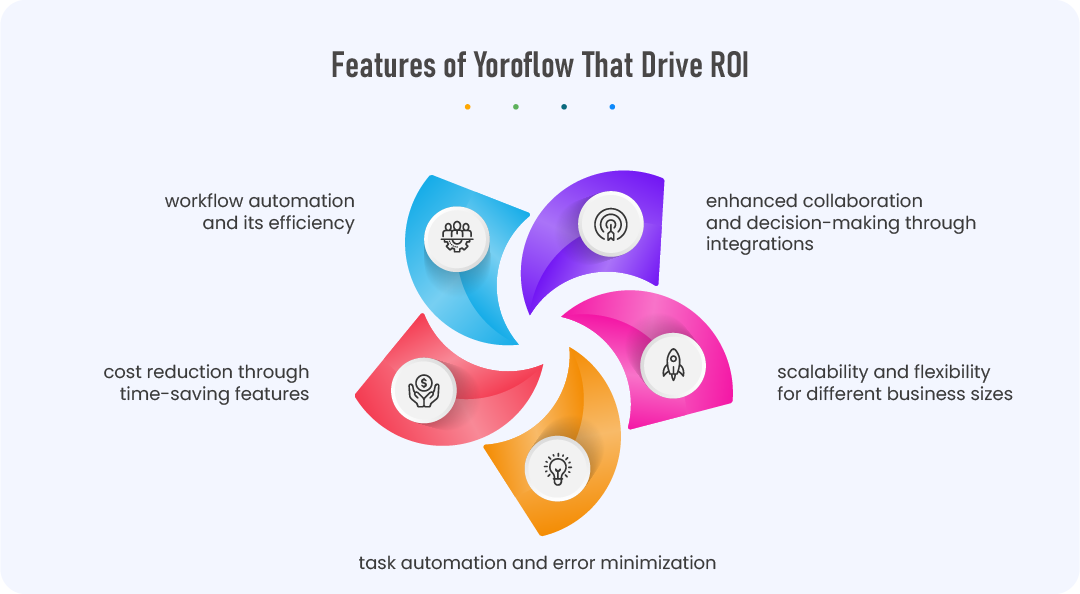
Workflow Automation and Its Efficiency
Yoroflow automates repetitive and manual tasks, dramatically reducing the time employees spend on routine work. This frees up valuable human resources for more strategic and creative activities, improving overall operational efficiency. Automated workflows ensure tasks move seamlessly from one step to the next without delays, as approvals, document routing, and notifications are executed in real-time, reducing bottlenecks. Moreover, automating workflows ensures tasks are consistently carried out according to predefined rules, minimizing variability, enhancing reliability, and improving customer satisfaction—ultimately driving positive business outcomes.
Cost Reduction Through Time-Saving Features
By automating routine tasks such as data entry, task assignments, and status tracking, Yoroflow significantly reduces the number of labor hours required, cutting down time spent on administrative work and lowering overall labor costs. Automation also shortens cycle times, turning processes that once took days or weeks into ones completed in minutes or hours. This accelerated processing increases business throughput without the need for additional staff or resources. Moreover, Yoroflow optimizes resource allocation by helping businesses determine which tasks can be automated and which require human intervention, ensuring employees focus on high-value activities and preventing overstaffing.
Task Automation and Error Minimization
Manual processes are prone to errors, leading to costly mistakes, rework, or even legal consequences. Yoroflow reduces these risks by automating error-prone tasks like data entry, calculations, and compliance-related processes. Built-in validations and error-checking mechanisms further ensure accuracy by automating compliance checks, invoicing, and reporting, minimizing the likelihood of errors and protecting businesses from financial penalties. Additionally, automated workflows increase transparency and accountability, as tasks are tracked and employees are aware of their responsibilities and deadlines, reducing confusion and improving execution accuracy.
Enhanced Collaboration and Decision-Making Through Integrations
Yoroflow seamlessly integrates with collaboration tools like Slack, Microsoft Teams, and email systems, ensuring teams are always aligned and can communicate and collaborate on tasks in real-time across departments. These integrations also provide real-time access to critical data, allowing businesses to make quicker and more informed decisions using up-to-date information such as sales data, project progress, or customer feedback. Additionally, the improved workflow transparency ensures all stakeholders have visibility into task statuses and processes, reducing miscommunication and keeping decision-makers informed about timelines, bottlenecks, and task completion.
Scalability and Flexibility for Different Business Sizes
Yoroflow’s flexible architecture supports business growth by allowing companies to scale workflows without incurring significant costs or overhauling systems. As businesses expand, Yoroflow easily accommodates increased workflow complexity, additional users, and larger data volumes. It also offers customizable solutions tailored to the specific needs of various industries, including healthcare, finance, and marketing, enabling businesses to adapt quickly to changing market conditions without losing efficiency. Yoroflow’s pay-as-you-grow pricing model further ensures that businesses only pay for what they use, making powerful automation accessible to smaller companies while allowing larger businesses to scale as needed.
Calculating ROI with Yoroflow
1. Framework for Calculating ROI Using Different Business Scenarios
- Identifying Key Metrics: To calculate ROI, businesses should identify key performance indicators (KPIs) relevant to their operations, such as increased productivity, cost savings, reduced error rates, and enhanced collaboration. These metrics will provide a clear picture of the value generated by using Yoroflow.
- Scenario Analysis: Different business scenarios—such as varying levels of automation, departmental use cases, or industry-specific implementations—should be analyzed. This allows businesses to understand how ROI may differ based on their unique needs and operational contexts.
2. Sample ROI Calculation
- Cost of Implementation: $100,000 (custom integration, training, and ongoing support)
- Annual Savings: $300,000 (operational efficiencies and labor cost reductions)
- ROI Calculation: ROI = {(300,00 – 100,000) / 100,000} * 100 = 200%
- Result: The large business achieves a 200% ROI in the first year as well.
3. Considerations for Both Short-Term and Long-Term ROI
Short-Term ROI:
- Immediate Savings: Calculate ROI based on quick wins, such as time saved on manual tasks or reduced operational costs that can be realized shortly after implementation.
- Payback Period: Determine how quickly the initial investment can be recouped, which is crucial for cash flow management, especially for smaller businesses.
- Initial Productivity Gains: Consider immediate improvements in workflow efficiency and team output as key indicators of short-term ROI.
Long-Term ROI:
- Sustained Benefits: Evaluate how ongoing use of Yoroflow will continue to drive productivity, cost savings, and error reduction over time.
- Scalability Benefits: Assess the long-term impact of scaling operations and how Yoroflow’s flexibility allows businesses to adapt to changing demands without significant additional costs.
- Strategic Growth: Consider the broader implications of enhanced collaboration, improved customer satisfaction, and innovation that arise from automating processes. These factors can significantly contribute to long-term growth and competitive advantage.
Challenges and Considerations
Potential Implementation Challenges
Organizations face significant challenges during Yoroflow implementation, primarily stemming from adoption resistance and integration complexities. Employees may be apprehensive about adopting new technology due to concerns over job security, increased workloads, or unfamiliarity with the platform, which can lead to lower engagement and slower adoption rates.
Additionally, integrating Yoroflow with existing systems, such as CRM, ERP, and project management tools, can be complex. Compatibility issues, data migration challenges, and the need for custom API integrations may complicate the process, potentially resulting in delays and increased costs. Addressing these challenges is essential for a successful implementation.
Mitigating Risks and Ensuring a Smooth Transition
To mitigate risks and ensure a smooth transition to Yoroflow, organizations should invest in comprehensive training programs that highlight the platform's benefits and ease of use through hands-on workshops, webinars, and ongoing support.
Adopting a phased rollout strategy allows for a pilot program in one department to identify and address challenges before a full-scale implementation, providing valuable feedback for necessary adjustments.
Additionally, establishing continuous support and feedback loops enables employees to express concerns and suggestions during the transition. This support, provided through dedicated help desks or user communities, ensures prompt issue resolution and fosters a smoother transition overall.
Customization for Specific Business Needs
Customization of Yoroflow is essential to maximize its effectiveness in aligning with unique business processes and requirements. This involves tailoring workflows, which may include designing custom forms, automating specific processes, or configuring integrations with existing systems for a cohesive workflow.
Engaging key stakeholders from various departments in the customization process ensures that the solution addresses the diverse needs of the organization. By involving end-users in discussions about their pain points and desired outcomes, businesses can achieve more relevant and effective customizations.
Additionally, customization should be an ongoing effort, requiring regular evaluation and adjustments as business needs evolve. Regularly reviewing workflows and incorporating user feedback helps ensure that automation continues to deliver value and aligns with the organization's strategic goals.
Conclusion
Implementing Yoroflow can significantly enhance your organization's return on investment (ROI) by optimizing operational efficiencies and reducing costs. Through process automation, businesses can streamline workflows and minimize manual errors, leading to substantial savings and productivity gains. Studies from Deloitte indicate that companies utilizing automation technologies can achieve operational cost reductions of 20-30%, while Forbes highlights that organizations have experienced time savings of 20-40% in task completion.
Moreover, the platform's powerful data analytics capabilities provide actionable insights that drive strategic decision-making, ultimately contributing to improved profitability. As businesses continue to scale, Yoroflow's flexibility ensures that it can adapt to evolving needs without the burden of additional software costs.
In summary, the multifaceted benefits of Yoroflow not only lead to enhanced productivity but also establish a robust framework for achieving significant ROI. By investing in this advanced platform, organizations can position themselves for sustained growth and success in an increasingly competitive landscape.